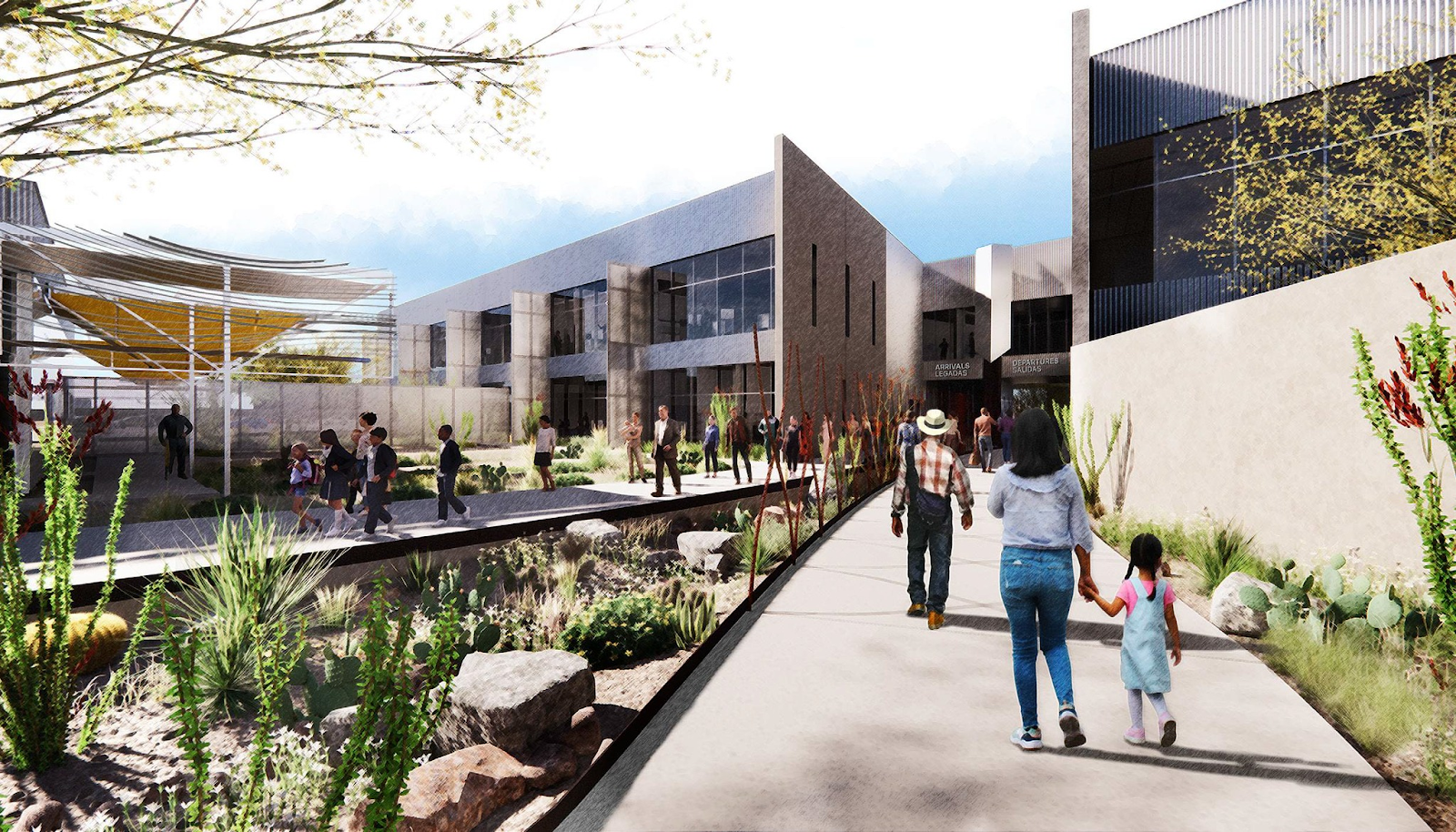
Lightening the carbon footprint one purchase of asphalt, concrete, glass and steel at a time
A look at land port projects using low embodied carbon building materials
GSA is responsible for constructing and maintaining land ports of entry (LPOEs) along the nation’s borders in support of the U.S. Department of Homeland Security-Customs and Border Protection and other federal agencies. This is the first in a quarterly series of updates on LPOE modernization projects.
In a place that gets more than 300 days of sunshine a year, adding solar panels to a new roof in San Luis, Arizona, is a sustainability no-brainer. But looking at other places to reduce greenhouse emissions may be a little harder to see.
Buildings and construction materials are responsible for 40% of carbon emissions, making them the fourth-largest global contributor, according to GSA’s Chief Architect Chuck Hardy.
Building operations such as heating, cooling and electricity make up most of those carbon emissions. But embodied carbon emitted from infrastructure and construction materials are responsible for almost a third of the built environment’s annual global carbon dioxide (CO2) emissions, according to Architecture 2030, an independent, nonprofit organization monitoring greenhouse gas emissions.
As buildings become increasingly more efficient to operate, the climate conversation has been expanding to consider the impact of building materials, including the carbon embodied in the building itself.
Embodied carbon refers to greenhouse gas emitted from mining, harvesting, processing, manufacturing, transporting, installing, maintaining, using and disposing of construction materials. In other words, it is the carbon footprint of a building or structure from start to finish, including how the materials were created, and how much carbon was emitted along the way in the supply chain.
In 2022, GSA made cutting the carbon load in building materials as its next big sustainability effort. This year, the agency collaborated with the U.S. Department of Transportation’s Federal Highway Administration and the U.S. Environmental Protection Agency to launch [PDF - 125 KB] GSA’s interim low embodied carbon (LEC) requirements for four key categories of low embodied carbon construction materials: asphalt, concrete, flat glass and steel.
GSA estimates it will purchase $400 million of LEC materials for these pilot projects.
The pilot gives GSA an opportunity to evaluate its LEC requirements before applying them to the full $2.15 billion appropriation from the Inflation Reduction Act.
GSA expects to learn more about the construction material markets, suitability of the requirements for different types of projects, availability of environmental product declarations (EPDs), and how vendors will source LEC materials in compliance with the Buy American and Trade Agreements Acts. Given the growth of state, local, and Federal Buy Clean policies, and increases in market demand for more sustainable options, developing EPDs can be a great business decision for companies making construction materials and products.
The pilot consists of 11 projects, with five at Land Ports of Entry (LPOE) along our northern and southern borders.
San Luis I LPOE, Arizona
Every year, about 2.5 million pedestrians use the LPOE that connects Mexico with the southwestern tip of Arizona, just miles from the California border. It is a vital gateway for people who tend to the critical agricultural industry, which grows melons, broccoli, and about 90% of leafy greens consumed annually by U.S. consumers during the winter.
A $307 million modernization project, funded by the Bipartisan Infrastructure Law and the Inflation Reduction Act, will upgrade the undersized mid-1980s port with larger, modern buildings and double the capacity for vehicle inspections at Arizona’s second-busiest non-commercial port.
The project will feature solar panels – about 5,000 square feet worth – and use LEC asphalt, concrete and steel. The expansion and modernization of San Luis Land Port of Entry aims to make it one of the first net-zero LPOEs in GSA’s portfolio under the Federal Sustainability Plan.
The modernization project broke ground in June and construction is scheduled to be completed in fall 2028.
Otay Mesa LPOE, California
In August, GSA began to repair cracks, potholes and erosion from the thousands of vehicles crossing daily using LEC asphalt at California’s busiest commercial port.
Nearly 1 million commercial trucks, 2.1 million pedestrians and 5 million non-commercial vehicles pass through the port annually.
This project is not actually part of the new pilot, but the $1.85 million-dollar lane upgrades are part of a larger modernization project [PDF - 1 MB] funded by the Bipartisan Infrastructure Law.
Dunseith LPOE, North Dakota
Plans to modernize and expand [PDF - 447 KB] the Dunseith LPOE along the North Dakota-Canada border are underway. The project is expected to use LEC asphalt, concrete, flat glass and steel.
The Dunseith LPOE is the only commercial inspection facility in north-central North Dakota and sees the third most truck traffic in the state. Most of its non-commercial visitors are from both sides of the border destined for the International Peace Garden.
Other LPOE projects planning to use LEC asphalt, concrete and steel include:
- World Trade Bridge LPOE in Laredo, Texas.
- Kika de la Garza LPOE in Pharr, Texas.
- LPOE in Ysleta, Texas.

 U.S. General Services Administration
U.S. General Services Administration
